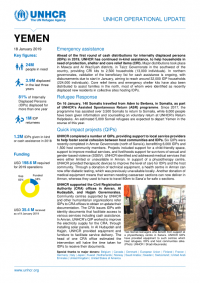Yemen UNHCR Operational Update, 18 January 2019
Key figures:
24M people in need
3.9M displaced
81% of IDPs displaced for more than one year
1M IDP returnees
1.2M IDPs given in-kind or cash assistance in 2018
Funding in 2018
USD 198.6 M required for 2019 operations
USD 35.4 M received as of 9 January 2019
Emergency assistance
Ahead of the first round of cash distributions for internally displaced persons (IDPs) in 2019, UNHCR has continued in-kind assistance, to help households in need of protection, shelter and core relief items (CRI). Major distributions took place in Mawza and Al Wazi’iyah districts, in Taizz Governorate in the southwest of the country, providing CRI kits to 2,500 households (13,000 individuals). In northern governorates, validation of the beneficiary list for cash assistance is ongoing, with disbursements due to start in January, aiming to reach around 32,000 IDP households (224,000 individuals). Core relief items and emergency shelter kits have also been distributed to assist families in the north, most of whom were identified as recently displaced new residents in collective sites hosting IDPs.
Refugee Response
On 16 January, 140 Somalis travelled from Aden to Berbera, in Somalia, as part of UNHCR’s Assisted Spontaneous Return (ASR) programme. Since 2017, the programme has assisted over 3,500 Somalis to return to Somalia, while 6,000 people have been given information and counselling on voluntary return at UNHCR’s Return Helpdesks. An estimated 5,000 Somali refugees are expected to depart Yemen in the course of this year.
Quick impact projects (QIPs)
UNHCR completed a number of QIPs, providing support to local service providers to help foster social cohesion between host communities and IDPs. Six QIPs were recently completed in Amran Governorate (north of Sana’a), benefitting 6,000 IDPs and 1,500 host community members. Projects included support for a child-friendly space, support to improve medical services, and livelihoods support for survivors of sexual and gender-based violence (SGBV). UNHCR identified and addressed medical services that were either limited or unavailable in Amran. In support of a physiotherapy centre, UNHCR provided therapeutic devices to improve the level of care for IDPs and the host community. Through a donation of technical equipment, a health centre in Amran can now offer diabetic testing, which was previously unavailable locally. Another donation of medical equipment means that women needing caesarean sections can now deliver in Amran, whereas they used to have to travel 80km to Sana’a for safe c-sections.
UNHCR supported the Civil Registration Authority (CRA) offices in Amran, Al Hudaydah, and Hajjah Governorates. Community centres supported by UNHCR and other humanitarian organisations refer IDPs to CRA offices to obtain or update their documentation. The CRA issues IDPs with identity documents that facilitate access to various services including cash assistance.
In Amran, UNHCR’s QIP worked to improve the electricity supply for the CRA, through installing solar panels. In Al Hudaydah and Hajjah, UNHCR provided equipment and furniture to facilitate service delivery. The head of one CRA office estimated the intervention will halve the time taken for IDPs to receive their documents.
https://reliefweb.int/report/yemen/yemen-unhcr-operational-update-18-january-2019


